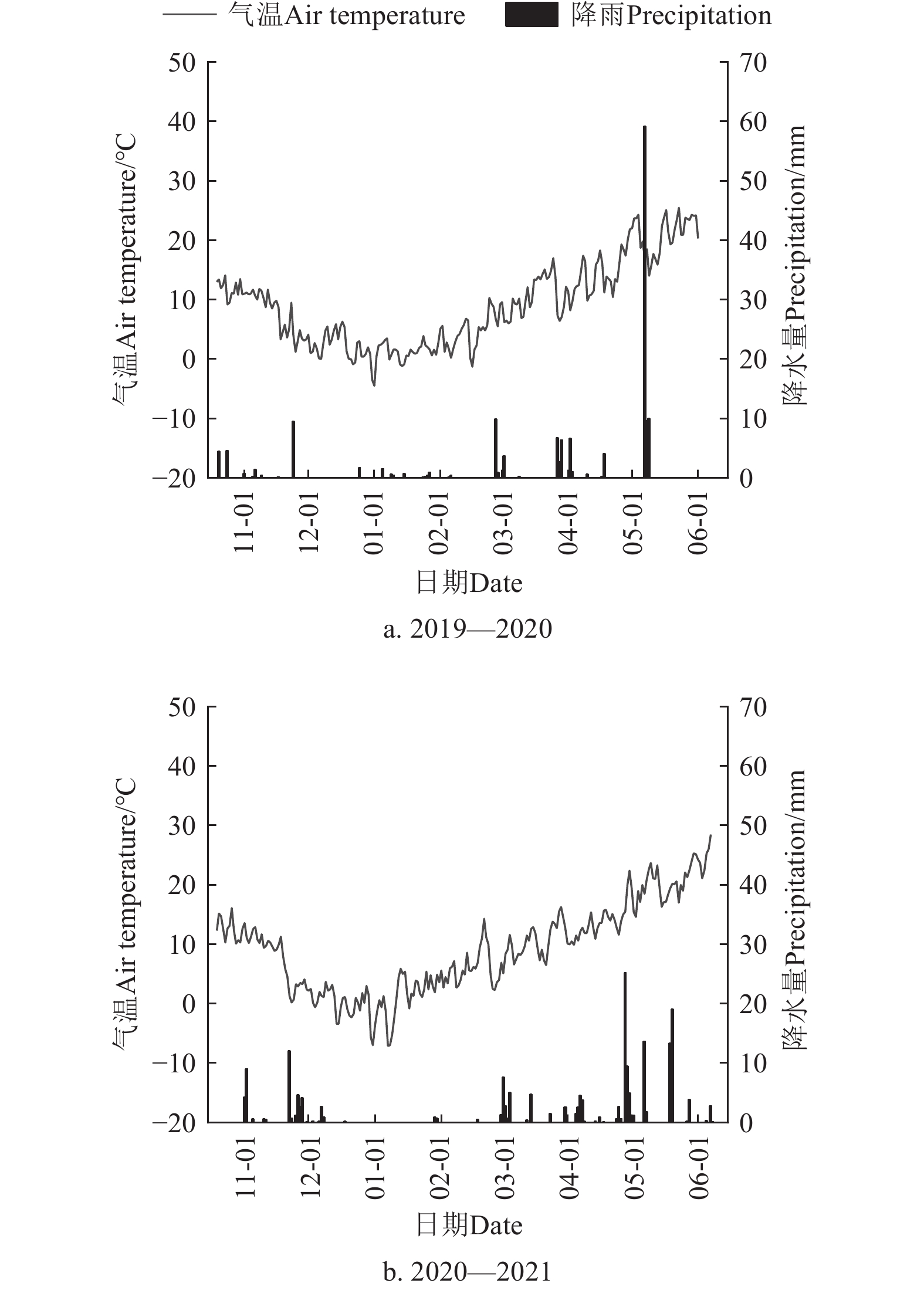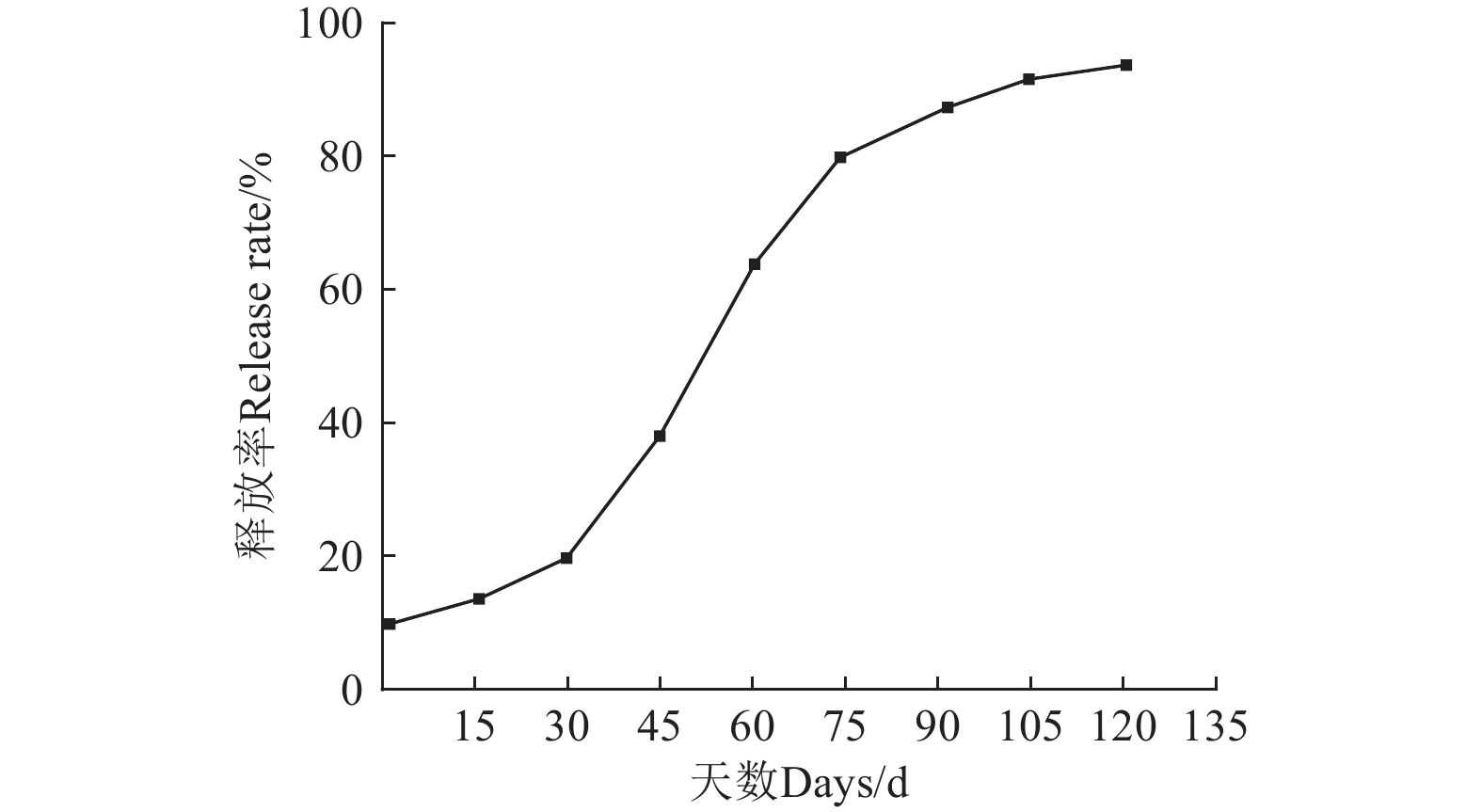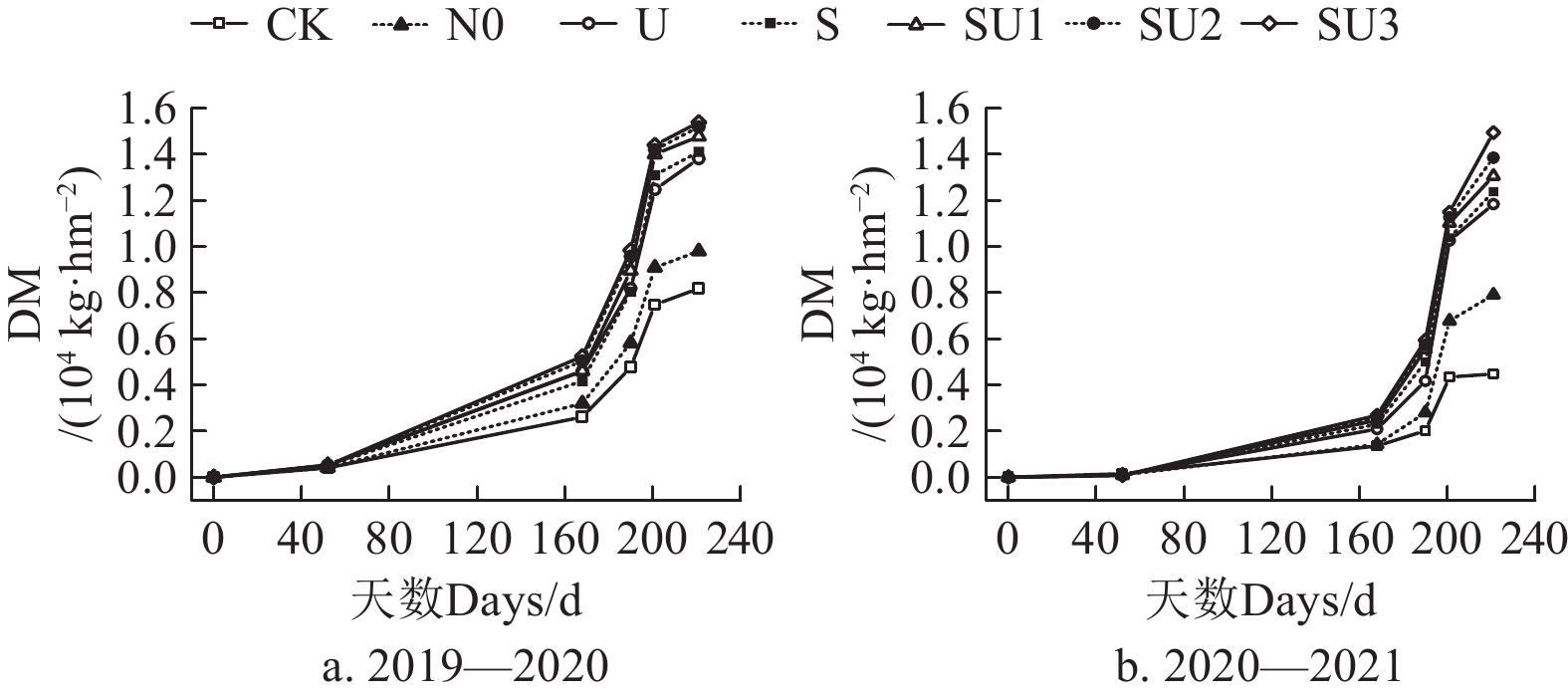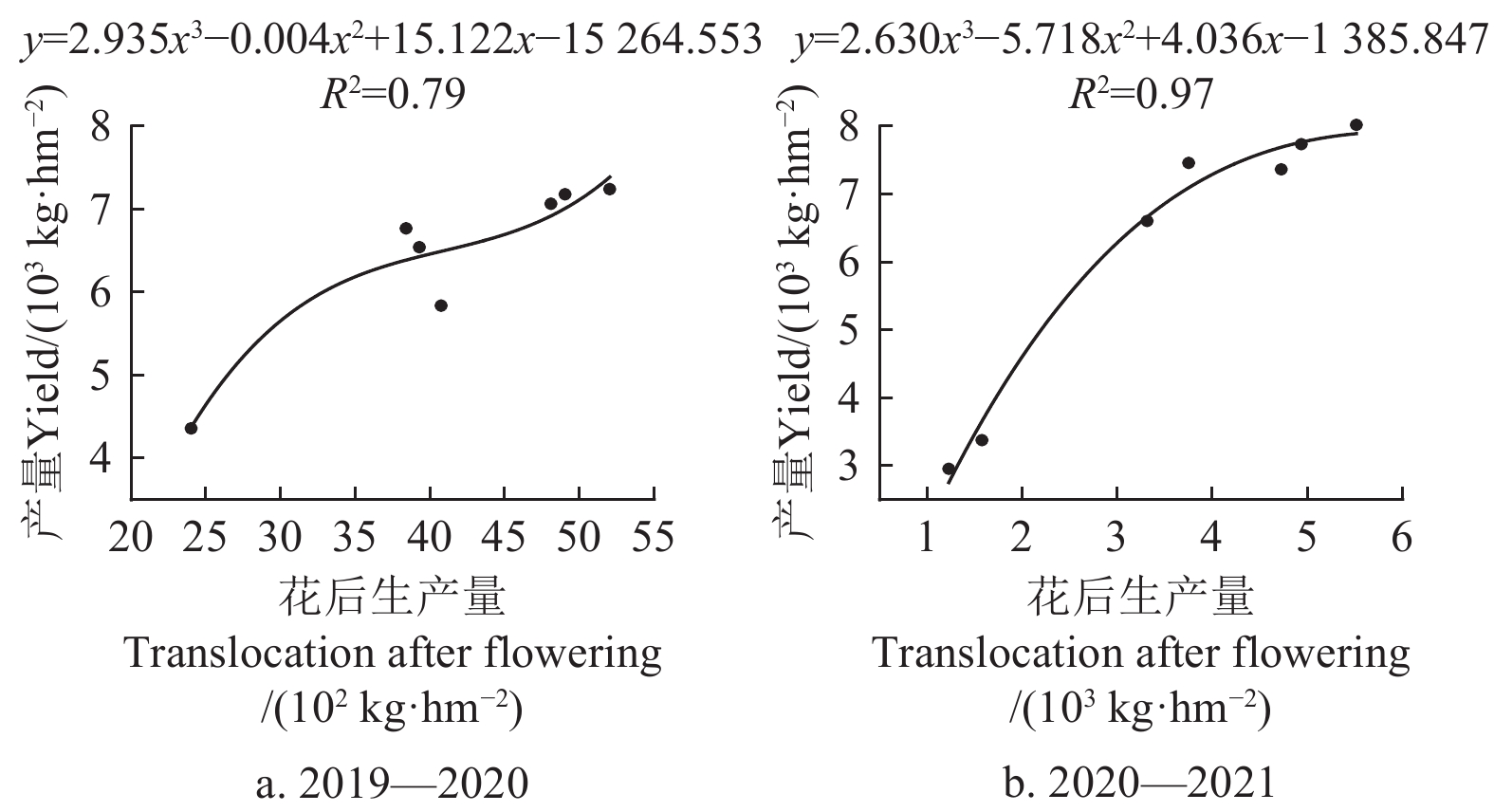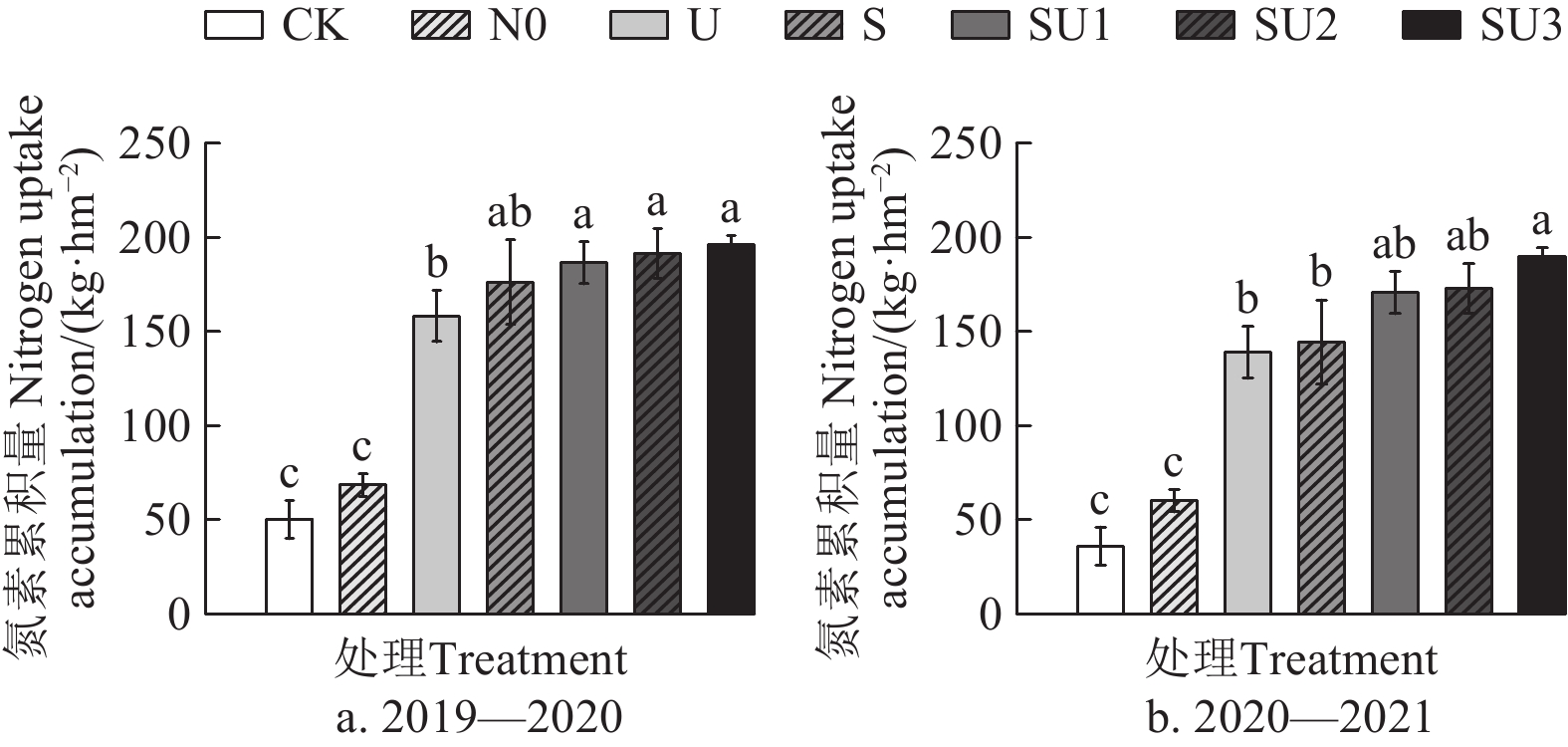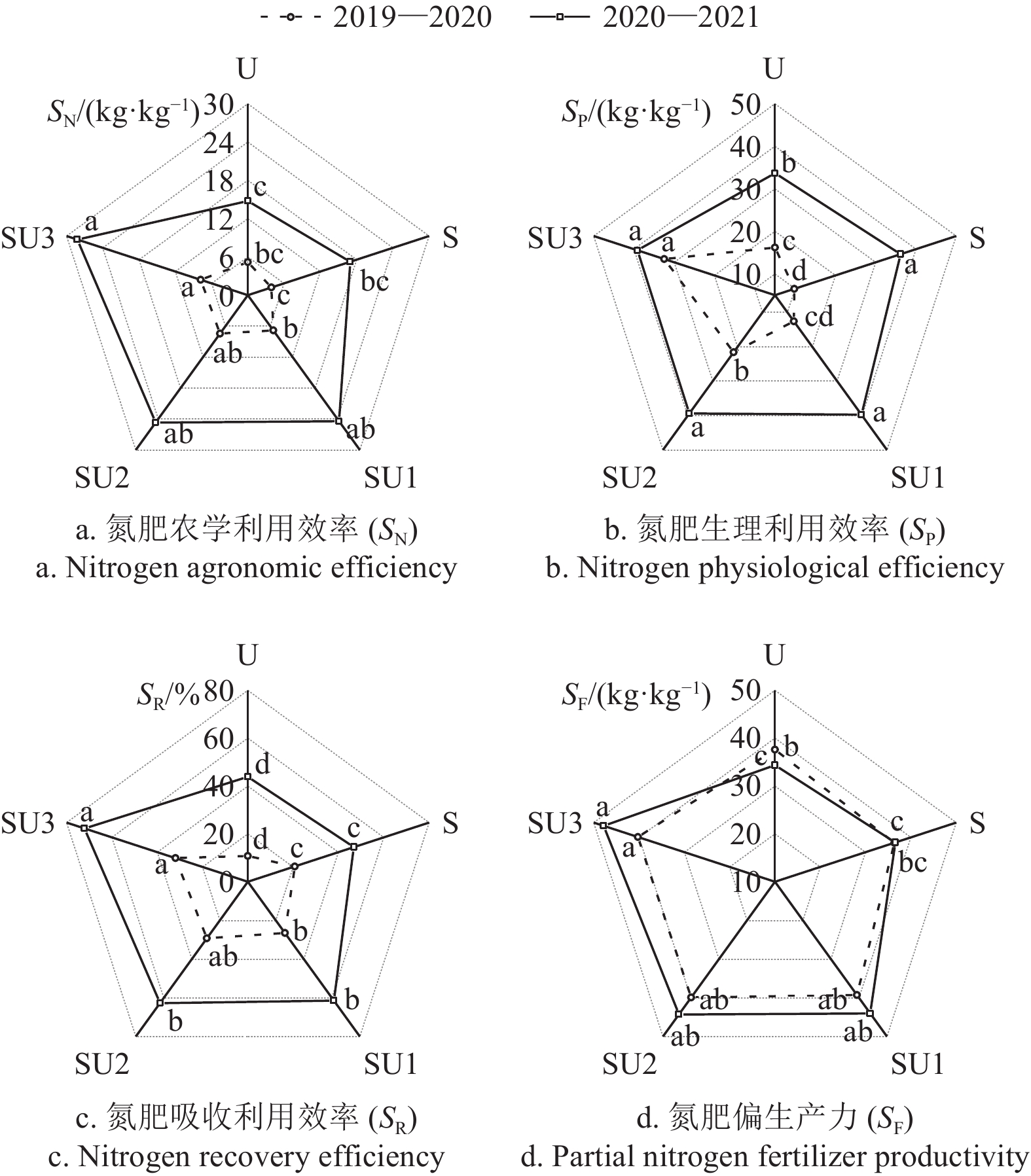Combined the application of slow-release N fertilizer and urea to improve the yield and N use efficiency of winter wheat
-
摘要:
为探究匹配冬小麦氮素需求规律的最佳缓释氮肥与尿素配施比例,优化施肥结构,达到氮肥高效利用与经济效益“双赢”的目标,该研究以冬小麦为研究对象,通过2 a(2019—2020年和2020—2021年)田间试验,设置7个施肥处理:仅施尿素(U)、仅施缓释氮肥(S)、缓释氮肥与尿素1:3配施(SU1)、缓释氮肥与尿素1:1配施(SU2)、缓释氮肥与尿素3:1配施(SU3)、不施氮肥(N0)和不施肥(CK),研究缓释氮肥配施比例对冬小麦干物质积累和转运、产量和氮肥利用效率的影响。结果表明,冬小麦干物质快速生长期和最大累积速率随缓释氮肥配施比例的增加而增加,缓释氮肥与尿素配施的冬小麦干物质平均累积速率比普通尿素提高1.90%~19.91%。缓释氮肥与尿素配施可在改善花前干物质转运量的同时提高花后生产量,花后干物质生产量对籽粒贡献率达53.18%~71.83%。产量随缓释氮肥配施比例的增加而显著提高,SU3处理2 a产量分别为7 243和8 021 kg/hm2,较S和U处理分别提高了7.25%和16.07%,其经济效益较S和U处理提高了15.18%和25.67%。与仅施尿素相比,缓释氮肥与尿素配施可显著提高氮肥利用效率,但SU2和SU3处理无显著差异(P>0.05)。综合考虑,在施氮量180 kg/hm2条件下,缓释氮肥与尿素配施比例50%(SU2),可实现冬小麦绿色高产高效,其产量为7 458 kg/hm2,氮肥吸收利用效率为45.97%,农学利用效率、生理利用效率和偏生产力分别为16.07、30.49和42.09 kg/kg。该研究可为冬小麦合理施肥提供理论依据。
Abstract:Here, the best ratio of slow-release nitrogen fertilizer to urea was determined to match the nitrogen demand of winter wheat. The fertilizer application structure was also optimized for the efficient use of nitrogen fertilizer and economic benefits. Seven fertilizer treatments were applied into the winter wheat in a two-year field trial: urea only (U), slow-release N fertilizer only (S), slow-release N fertilizer with the urea 1:3 (SU1), 1:1 (SU2), and 3:1 (SU3), no N fertilizer (N0) and no fertilizer (CK). A systematic investigation was made to explore the effects of slow-release N fertilizer application rates on the dry matter accumulation and transport, yield, and N fertilizer use efficiency of winter wheat. The results showed that there was an increase in the rapid growth period and the maximum accumulation rate of dry matter in the winter wheat with the proportion of slow-release N fertilizer. The average dry matter accumulation rate of slow-release nitrogen fertilizer combined with the urea increased by 1.90% to 19.91%, compared with the ordinary urea. The proportion of slow-release nitrogen fertilizer application posed a significant impact on the post post-flowering dry matter production. There was an increase in the pre and post post-flowering dry matter transport. Meanwhile, the post post-flowering dry matter production was contributed 53.18% to 71.83% of the grain yield. The yield increased significantly with the increasing proportion of slow-release N fertilizer, with the two-year yields of 7 243 and 8 021 kg/hm2 in the SU3, which were 7.25% and 16.07% higher than the S and U treatments, respectively, and their economic benefits were 15.18% and 25.67%, respectively. The cumulative nitrogen uptake of winter wheat increased by the application of slow-release nitrogen fertilizer with the urea. Specifically, the cumulative nitrogen uptake values were 24.08% to 36.63% higher than those in the SU3, compared with the U treatment. The slow-release N fertilizer with the urea was improved the N fertilizer use efficiency. The agronomic use efficiency, physiological use efficiency, and biased productivity were improved in the SU3, compared with the U treatment. But there was no significant difference between SU2 and SU3 treatments (P>0.05). The slow-release N combined with the urea was significantly improved the N use efficiency, but there was no significant difference between SU2 and SU3 treatments (P>0.05). Therefore, the slow-release N fertilizer mixed with the urea can be expected to improve the winter wheat yield and N use efficiency. The dry matter growth period was significantly extended to promote the maximum accumulation rate for the post-flowering dry matter production and its transport rate to the seed. By comprehensive consideration, under the condition of nitrogen application rate of 180 kg/hm2, the combination of slow-release nitrogen fertilizer and urea application ratio of 50% (SU2) can achieve green, high yield, and high efficiency of winter wheat. Among them, the yield is 7 458 kg/hm2, the nitrogen fertilizer absorption and utilization rate is 45.97%, and the agronomic utilization rate, physiological utilization rate, and partial productivity are 16.07, 30.49, and 42.09 kg/kg, respectively. The finding can provide the theoretical basis for the rational fertilization of winter wheat. Follow-up studies need to consider the environmental effects and carbon and nitrogen emissions, together with the impact of slow-release nitrogen fertilizer combined with the urea on the soil nitrate nitrate-nitrogen distribution, ammonia volatilization, and greenhouse gas emissions. Further research can be conducted to determine the amount and proportion of slow-release nitrogen fertilizer and urea application for the high yield, high efficiency, and simultaneous emission reduction in winter wheat farmland.
-
Keywords:
- nitrogen /
- urea /
- fertilizers /
- wheat /
- Logistic equation /
- post-flower dry matter production /
- nitrogen fertilizer use efficiency /
- yield
-
0. 引 言
目前,许多传统薄膜材料的原料如聚乙烯(polyethylene,PE),聚氯乙烯(polyvinyl chloride, PVC),聚丙烯(polypropylene,PP)等石油基聚合物,由于其在土壤中极低的自然降解率,所堆积的残留物会破坏土壤结构,造成所谓的“白色污染”,并随着时间的推移通过生态系统的循环最终威胁到我们人类的健康[1-3]。针对这一现状,合理回收传统用膜及开发使用新型绿色生物可降解材料是当下控制和缓解的两种办法。但对于回收传统膜来说,由于较大的回收难度和较高的经济成本,阻碍了这一行动的实施[4]。因此,为了避免“白色污染”的进一步扩大,研制出具备传统石油基材料相同性能的绿色新型可生物降解材料是目前最优的方案。近年来,环境友好型材料得到了广泛关注和研究,其中的可生物降解材料能被微生物完全分解且不会对环境造成破坏,因此可以取代石油衍生物材料,解决环境污染问题。可生物降解材料,例如聚己内酯(polycaprolactone,PCL),聚乳酸(polylactic acid,PLA),聚乙烯醇(polyvinyl alcohol,PVA)等是常见的化工合成材料。其中,PVA由于其具备优异的生物安全性和可降解性以及较强的力学性能,使其成为了薄膜领域在内的众多领域的研究热点[5]。然而,由于PVA分子结构中含有的大量亲水性的羟基基团,使得PVA膜在潮湿环境下容易吸收空气中的水分而发生溶胀,进而影响膜的性能,限制了PVA在特定环境下的应用[6]。此外,PVA膜由于其不具备阻隔紫外线的能力,在用于特定包装材料及农业用膜时,紫外线的辐射作用会加速薄膜的老化,甚至直接危害到农作物的生长。因此,提升PVA薄膜的耐水性和光学性能是促进其广泛应用的必要条件。
木质素(Lignin)是植物木质结构中三大主要成分之一,同时也是为数不多能够替代石油基多元醇提供芳香基化合物的可再生资源[7]。木质素主要是在化学制浆过程中作为一种废料产生的,但只有将近3.5%被用于生产高附加值产品[8]。因此探索木质素在高值化产品的应用对资源有效利用具有重要价值[9-10]。大量研究表明,木质素中含有大量的苯环,羰基和酚羟基,能够消除自由基使其具有一定的紫外吸收特性,同时赋予了生物相容性和可降解性等优点[11],且具备疏水基团如苯环,烷基链等。如ZHANG等 [12]将PVA与木质素进行共混后,木质素膜的机械性能和耐水性能都得到显著提升。IZAGUIRRE等[13]将木质素与壳聚糖(chitosan)进行共混后,共混膜的抗氧化性和阻隔紫外的能力得到了加强。因此,木质素的添加能够赋予和提高薄膜材料的性能。
水性聚氨酯(waterborne polyurethane,WBPU)是一种将传统溶剂型聚氨酯换以H2O作为介质使聚氨酯分散在其中的新型聚氨酯体系,其不仅具有传统溶剂基聚氨酯优良的耐磨性和机械性能[14-15],在作为填料分散在其他组分体系中凭借着可调节性的软硬段使其赋予了材料新的柔韧特效[16],而且具有环保、安全可靠的特点使其在生物医药等方面大放异彩。
因此,本文采取用微波法对木质素进行液化,将木质素液化物L(D)与PVA进行共混,并向体系中加入WBPU,制备L(D)/WBPU/PVA共混膜,对共混膜进行系统分析并探讨L(D)和WBPU对共混膜性能的影响。
1. 材料与方法
1.1 试验试剂
丙三醇、聚乙二醇-600(PEG-600)、木质素(脱碱)和水性聚氨酯(固含量为40%)均为分析纯,均由上海麦克林生化科技有限公司提供;浓硫酸(98%溶液)由广州化学试剂厂提供;聚乙烯醇
1799 型(醇解度98%~99%)由上海阿拉丁生化科技有限公司提供;无水乙醇(≥99.7%)购买于西陇科学股份有限公司。1.2 仪器设备
试验中主要使用的仪器设备:微波合成萃取仪,XM-MC-1,祥鹄科技有限公司;真空抽滤机,HQ-12CL-Ⅰ,祥鹄科技有限公司;旋转蒸发仪,Hei-VAP Advantage,Heidolph,德国;红外光谱仪,TENSOR27,Bruker,德国;X射线衍射仪,D8 ADVANCE,Brucker,德国;紫外分光光度计,UV-3300PC,MAPADA,中国上海;万能材料试验机,34SC-1,INSTRON,美国;台式扫描电镜,ProX,PHENOM,荷兰。
1.3 木质素的液化
将木质素放入120 ℃的烘箱进行脱水干燥处理120 min。之后,称取6 g木质素、24 g聚乙二醇-600(PEG-600)和6 g丙三醇放入圆底烧瓶中,在恒温磁力搅拌器上充分搅拌后,用移液枪吸取0.493 mL浓硫酸精准滴入混合试剂中以防止影响试验数据结果,继续搅拌一定时间后将烧瓶转移至微波合成萃取仪中 [17]。设置微波液化仪参数,仪器功率设置为600 W,反应时间设置在20 min,反应温度设置为160 ℃。待木质素液化结束后将其自然冷却至70 ℃,再将其进行真空抽滤,以除去残留固体,同时利用适量乙醇溶液把附着在烧瓶内的残留物冲洗后一并倒入漏斗中进行抽滤,待抽滤瓶中无液体滴漏后停止抽滤,将抽滤完成的混合液体移至旋蒸瓶中除去杂质乙醇。同时将抽滤后的滤纸放入60 ℃烘箱中干燥并进行后续称量。
木质素的液化率计算可按照式(1)进行计算:
W=W1−W2W1×100% (1) 式中,W为液化率,%;W1为木质素液化前的质量,g;W2为木质素未被液化的质量,g。
分别称量干燥后的空白滤纸和带有未被液化的木质素的滤纸,得出的质量分别为0.31 g和1.06 g,根据公式(1)可得木质素的液化率约为87%,该结果较为明显的看出大部分木质素已被液化。
1.4 LD/WBPU/PVA共混膜的制备
本文采用溶液浇筑法来制备L(D)/WBPU/PVA共混膜。首先准确称量20 g PVA倒入单口烧瓶中并加入380 mL去离子水,再将其放入油浴锅中加热,加热温度为90 ℃,并在瓶口安装冷凝管,磁力搅拌约2 h后制得PVA质量分数为5%的澄清溶液,之后,停止加热,待溶液冷却至60 ℃时,按照表1的配比,向PVA溶液中分别加入不同含量L(D)的和WBPU,并在该温度下磁力搅拌2 h,直至共混液充分混合。随后,取65 mL共混溶液放入180 mm×130 mm的玻璃板上,在室温下铺平晾凉,期间做好除泡处理,每组重复4次,静置48 h后可得到完整的共混膜样品,其中所制样品的各种配比及其命名详见表1。
表 1 不同L(D)、WBPU添加量占比Table 1. Different L (D) , WBPU addition% 薄膜名称
Film nameL(D) WBPU PVA 0 0 5%L(D)/PVA 5 0 10%L(D)/PVA 10 0 15%L(D)/PVA 15 0 20%L(D)/PVA 20 0 25%L(D)/PVA 25 0 9:1 L(D)/WBPU/PVA 15 1.67 8:2 L(D)/WBPU/PVA 15 3.75 7:3 L(D)/WBPU/PVA 15 6.43 6:4 L(D)/WBPU/PVA 15 10 5:5 L(D)/WBPU/PVA 15 15 注:L(D)为木质素液化物,PVA为聚乙烯醇,WBPU为水性聚氨酯,数字为L(D):WBPU掺比,实际添加量为占比×PVA质量,下同。 Note:L(D) is lignin (Dealkaline) liquefaction, PVA is polyvinyl alcohol, WBPU is waterborne polyurethane, the data is the blending ratio of L(D):WBPU, the actual addition amount is proportion × PVA mass, same below. 1.5 共混膜的表征
1.5.1 红外光谱图谱测定
采用红外光谱仪记录PVA膜和共混膜的FTIR-ATR光谱,分辨率为4 cm−1,范围为4 000~600 cm−1,扫描16次。
1.5.2 扫描电镜分析(SEM)
将膜的表平面和拉伸断截面用金溅射导电后,在10 kV下用Phenom ProX 扫描电镜观察。
1.5.3 薄膜透光性及厚度测定
将薄膜裁成适当尺寸,采用紫外可见分光光度计测定在200~400 nm波长范围内共混膜的抗紫外性能和在400~800 nm波长范围内共混膜的不透明度和透光率。取完整均匀的共混膜,使用精度为0.001 mm的厚度测试仪在薄膜上随机取5个点,测定其厚度并计算平均值、标准差。依照式(2)计算特定波长下(600 nm)共混膜的不透明度[18]。
不透明度=AbsX×100% (2) 式中,Abs为600 nm处共混膜的吸光度,X为共混膜的平均厚度,mm。
1.5.4 薄膜XRD表征测定
使用配备45 kV和200 mA CuKα辐射的X射线衍射仪收集XRD光谱,并在8°~80°范围内以10(°)/min的扫描速率进行扫描。
1.5.5 薄膜拉伸性能测定
采用万能材料试验机测试薄膜的拉伸性能。将样品分别裁成三组尺寸为75 mm×4 mm的哑铃状薄膜以进行拉伸强度测试,测试夹具为间距50 mm,速度设为0.05 m/min,计算每个样品的平均值和标准偏差。
1.5.6 薄膜的耐水性测定
从每张薄膜上割出2个尺寸为50 mm×50 mm的矩形薄膜。在60 ℃的真空烘箱中干燥24 h后,对样品的重量进行称量(W0),然后将其浸入100 mL去离子水中,浸没24 h后,使用滤纸去除样品表面多余的水,称量样品质量(Wt)。之后,放入60℃的烘箱中干燥24 h后,重新对此时的薄膜称量(Wd)。薄膜样品的吸水率(Wa)和水解率(Ws)使用以下公式测定[19]。
Wa=Wt−W0W0×100% (3) Ws=W0−WdW0×100% (4) 2. 结果与分析
2.1 共混膜红外光谱(FTIR)分析
L(D)、WBPU、PVA能否以任意比例混合是证明三者具有良好相容性的有效依据。因此,对加入不同百分比液化物量的L(D)/PVA共混膜和掺杂了不同百分比含量WBPU的L(D)/WBPU/PVA共混膜都分别进行FTIR测试。结果如图1a所示,在纯PVA膜中,3 275 cm−1和2 939 cm−1的峰分别为-OH和-CH2的收缩振动,1 654 cm−1处的峰为-C=O的收缩振动,在1 420 cm−1处的峰为-C-H的平面振动,1 087 cm−1处的峰则是-C-O的收缩振动。在L(D)/PVA共混膜中,所有的样品均具有木质素液化物和PVA特征官能团的吸收峰,但其位置和峰形大小都有一定的改变。在1 420 cm−1附近的峰为次甲基的吸收峰,峰形随着L(D)的加入从尖变宽,强度相对变弱,这表明L(D)和PVA具有较强的氢键作用[20]。同时,随着L(D)含量不断增加,3 275 cm−1处的羟基峰总体上朝着高波数方向移动,在20%时为最大,这表明L(D)与PVA之间发生了相互作用。
图1b为不同WBPU含量混膜的红外光谱图。3 368 cm−1附近宽峰为聚氨酯结构中的N-H和L(D)与PVA结构中羟基的吸收峰伸缩。1 731 cm−1附近则来自L(D)液化物与WBPU结构中-C=O的伸缩振动,且随着WBPU含量的增大,削弱了PVA中分子间的氢键作用,造成了PVA羟基峰逐渐蓝移[21-22]。同时由于固定含量PVA中的羟基数量不足,无法与WBPU中大量的羰基形成氢键,造成了能用于伸缩振动的羰基数目逐渐增多,对应的特征峰强度逐渐提高[23]。随着WBPU的不断加入,在1 087 cm−1附近属于PVA的-C-O伸缩振动强度呈现出从尖又强向着宽而弱变化,结晶度也随之衰弱。从以上结果表明,WBPU与L(D)/PVA具有较为不错的相容性。
2.2 共混膜扫描电镜(SEM)分析
由图2a可知,5%纯PVA膜的表面平整光滑,无明显颗粒,且拉伸断截面较为紧密、富有纹理。与纯PVA膜相比,L(D)/PVA膜表平面呈现出相似的特征,说明L(D)均匀分散在PVA基质中,形成了连续均匀相[24]。同时,随着木质素的不断加入,膜的拉伸断截面富有纹理且具有线条感,说明两者具有良好的生物相容性,膜的致密性好。但是随着木质素含量加到20%之后,膜的拉伸断截面的线条开始出现了一定程度上的紊乱,说明在分散过程中L(D)会出现一定程度的团聚现象,这可能会影响到膜的拉伸性能。
与2a图中的共混膜相比,随着WBPU含量的比例不断提高,图2b中L(D)/WBPU/PVA共混膜的断截面从有纹理愈发转变为粗糙状,在WBPU质量分数≥6.43%时尤为明显,且平面出现了较为明显的白色聚集体和复杂的结构交互,这在一定情况下会影响膜的综合性能。因此,WBPU的添加比例应该控制在6.43%以内,确保其能够均匀的分散在L(D)/PVA体系中[21,25]。
2.3 共混膜的光学性能分析
薄膜透明度是衡量透射光占入射光百分比强度的一项光学性能,也是评价薄膜材料性能好坏的特征[24]。从表2中可以清晰地观察到共混膜的厚度随着L(D)百分比的加入而逐渐提升,表明L(D)与PVA能够呈现稳定的相容,这与前面红外的分析基本吻合,且在可见光区的透明度较好。
表 2 不同薄膜的厚度及不透明度Table 2. Thickness and opacity of different films薄膜名称
Film name厚度
Thickness/mm吸光度Absorbance
(600 nm)Abs不透明度
Opaqueness/%PVA 0.115±0.007 0.0736 0.64±0.04 5%L(D)/PVA 0.117±0.007 0.1344 1.15±0.07 10%L(D)/PVA 0.127±0.019 0.2124 1.67±0.25 15%L(D)/PVA 0.135±0.020 0.2421 1.79±0.27 20%L(D)/PVA 0.142±0.014 0.2771 1.95±0.19 25%L(D)/PVA 0.157±0.018 0.3010 1.92±0.22 9:1 L(D)/WBPU/PVA 0.149±0.011 0.5392 3.61±0.28 8:2 L(D)/WBPU/PVA 0.160±0.011 0.6493 4.06±0.27 7:3 L(D)/WBPU/PVA 0.191±0.014 1.0047 5.26±0.38 6:4 L(D)/WBPU/PVA 0.223±0.016 1.3836 6.21±0.46 5:5 L(D)/WBPU/PVA 0.245±0.014 1.8714 7.63±0.45 然而,WBPU的加入所呈现的现象则与其不同。在WBPU的比例小于3.75%时,共混膜的厚度也随着WBPU含量的增加而逐渐提升,但在超过3.75%后其厚度增加的幅度较大,这或许能进一步证实在WBPU质量分数时≥6.43%时,WBPU与L(D)/PVA基底存在着一定的相分离。所有的薄膜样品不透明度小于8,可以认为共混膜是透明的,如果应用于食品包装可以避免消费者对食品外观的误判。
不同L(D)和WBPU含量的共混膜样品如图3所示,可以直观看出L(D)的加入使得共混膜呈现褐色,共混膜的颜色会随着L(D)含量的增加而加深,且WBPU的加入会加深L(D)中的褐色。
紫外辐射对自然界动植物以及塑料制品造成一定程度影响,因此生产出能够较大程度在紫外光区吸收紫外光的产品具有很高的市场价值[26]。由图4共混膜紫外-可见光图谱可知,纯PVA膜在紫外区的吸收很小,例如在400 nm处时其透光率达到81.44%,而加入5%L(D)后共混膜的透光率降低至34.53%,这是由于PVA特殊的分子结构中不存在不饱和键,而恰好属于芳香族化合物的木质素,其骨架结构中的羰基以及不饱和共轭双键等能够对紫外线进行有效吸收[27],同时木质素中还具备特有的酚羟基,使其能够形成吸收紫外的共轭反应[28]。因此,共混膜吸收紫外的能力会随着L(D)的不断加入而增强,当L(D)含量为25%时,共混膜在400 nm处的透光率仅为1.64%,这能够说明L(D)能够明显改善共混膜的抗紫外性能。WBPU的加入同样使得共混膜的抗紫外能力得到了增强,在400 nm处,15%L(D)/PVA共混膜的透光率为7.69%,而加入了3.75%WBPU后,其光透过率降至1.57%,这可能是因为WBPU与L(D)形成了某种紫外光稳定体系,并随着WBPU含量的不断增加,400nm处的透光率接近于0。L(D)和WBPU的加入提升了共混膜的抗紫外性及抗老化性,这一特性可以应用于阻碍紫外线的包装薄膜和农业用膜[29]。但两者的加入都在某种程度上影响到了对可见光的透过率,这将在后续的研究中进行改善。
2.4 共混膜X射线衍射(XRD)分析
从图5a中可以看出纯PVA聚合物的特征衍射峰的分别出现在2θ=19.2°和26.3°。
当加入L(D)时,L(D)/PVA共混膜衍射图谱形状与纯PVA膜的无太大差异,说明L(D)均匀分散在PVA体系中。基于图5a的分析,图5b中L(D)/WBPU/PVA共混膜的XRD图谱中多出了一个2θ=22.6°的衍射峰,不难理解这属于WBPU硬段的结晶所导致的特征衍射信号峰[30]。当两者比例随着WBPU的不断增加,属于WBPU的衍射信号为缓慢增强,这可能是因为WBPU含量较低时,较高含量的L(D)会阻碍WBPU有序硬段间相互作用,但随着WBPU含量较高时,固定含量的L(D)反而促进了与WBPU链段间的相互作用,促使无规则软段部分结晶化,有序硬段部分增强[31]。同时在2θ=26.3°所展现的特征信号峰的强度也随之逐渐变弱,原因在于WBPU的加入能够一定程度的削弱L(D)/PVA分子间的强相互作用力,从而间接导致了共混膜的结晶度降低。
2.5 共混膜拉伸性能分析
拉伸性能好坏是衡量薄膜抗拉扯能力和断裂程度的重要参考标准,同时也是力学表征试验的基础因素。图6展示了两种共混膜的力学拉伸性能。
由图6a可知,随着L(D)含量的不断加入,L(D)/PVA共混膜的拉伸性能呈现的变化趋势为先升后降,且当加入到15%的L(D)时,共混膜的拉伸强度达到顶峰(46.23 MPa),与纯PVA膜的拉伸强度(42.07 MPa)相比提升了10.60%。这是由于低含量的L(D)加入,其特有的空间网络结构与PVA混合发生相互作用后,导致共混膜形成了一种刚性结构,同时两者之间还能够形成分子间氢键,从而提升了拉伸性能[32]。继续提高L(D)比例至20%~25%时强度则有所下降,其原因可能是共混膜中过多的L(D)无法与PVA基体很好的结合,削弱了两者之间的相互作用,同时L(D)形成了一定程度的堆积[24],最终造成了膜拉伸强度的下降。断裂伸长率也呈现出相同的趋势。
与上述分析的情况不同,图6b所展示的共混膜相对于未加入WBPU的共混膜来说整体的拉伸强度下降幅度很大,且随着WBPU的不断加入,拉伸强度也呈现下降趋势,这是因为WBPU中某些链段能够代替L(D)和PVA分子间和分子内氢键作用与L(D)和PVA分子间氢键进行相互作用,削弱了L(D)和PVA分子间的作用力[33-34]。同时L(D)/WBPU/PVA共混膜的断裂伸长率与未添加WBPU的L(D)/PVA共混膜相比,均低于后者,且随着WBPU的不断增加,断裂伸长率也随之降低,直至WBPU的添加量≥10%时才开始回升。分析认为,是由于引入的L(D)使得WBPU中硬段含量上升,分子之间的交联度增强,降低了共混膜随拉伸强度变化而发生形变的能力,导致膜的脆性变大,断裂伸长率下降[34-35]。后来的回升则是由于共混膜中的L(D)不足以充当过多的WBPU硬段。
2.6 共混膜耐水性分析
图7a展示了L(D)的含量对共混膜吸水性和水溶性的影响规律。
PVA是强亲水性材料容易吸水膨胀,但随着L(D)的加入其吸水性逐渐降低,当加入15%的L(D)时,共混膜的吸水率从532%降低至362%,其耐水性提升了32%,这是因为L(D)进行液化后,部分羟基被酯化不与羰基产生共轭效应,与水形成氢键的能力变小,同时液化后的产物还有酚羟基,导致疏水性能的增加[36]。而水溶性的变化走势较为复杂,呈现出微弱的降-升-降的变化。相比于纯PVA膜,加入5%L(D)的共混膜其水溶性从42%下降至35%,但当L(D)含量高于5%时,膜的水溶性在35%附近波动。造成这一现象的原因可能是由于L(D)疏水性造成的,同时还与L(D)本身复杂的刚性分子结构有这一定联系[37]。
而加入WBPU的水溶性则没有这种复杂变化。由图7b可知,L(D)/WBPU/PVA共混膜与L(D)/PVA共混膜对比整体的吸水性和水溶性都明显降低。随着WBPU的不断加入,吸水性为降低的走势,其中5:5L(D)/WBPU/PVA共混膜的吸水率甚至降至170%,水溶性也降至18%,耐水性相较于纯PVA膜来说提升了68%。这是因为WBPU吸水性低且具有很强的尺寸稳定性,交联作用下削弱了PVA中大量的羟基氢键的形成[24];而水溶性也呈现出不断下降的趋势,同样是因为在整个共混膜中体系中PVA的占比随着WBPU的不断加入而越来越小,使得降低了共混膜的亲水性能,水分子由膜的内层逐渐向表面扩散[38]。
3. 结 论
1)一定含量L(D)的加入在一定程度上能够提升L(D)/PVA共混膜的拉伸强度,且在L(D)含量为15%时拉伸强度从42.07 MPa增加到46.53 MPa,提高了10.60%;并且L(D)的加入能够显著的改善共混膜吸收紫外光辐射的能力,且透明度较好。同时L(D)的加入改善了共混膜整体的耐水性。综合考虑,L(D)加入量为15%时,共混膜整体性能最佳。
2)在WBPU的加入下,L(D)/WBPU/PVA共混膜整体的抗紫外能力和耐水性都得到进一步的增强。但是在力学性能上,由于WBPU能够削弱L(D)和 PVA分子间作用力,拉伸强度上则有一定程度的下降。因此,综合考虑下7:3比例下的共混膜性能最佳。
3)在该试验研究和过程分析中,经过液化后的L(D)和WBPU都对PVA膜的性能产生了一定影响,尤其是在抗紫外性能和耐水性能上表现出了优异的提升效果。L(D)/WBPU/PVA共混膜可用作良好的紫外屏蔽材料和防水材料,可应用于特殊包装和地膜等,同时为L(D)/WBPU/PVA共混膜制备的合理性提供了理论依据,并对其在农用膜的应用有一定的参考意义。
-
表 1 各处理设计
Table 1 Design of different treatments
处理
Treatment缓释氮肥与
尿素比例
Ratio of slow-
release N
fertilizer to urea施肥量Fertilizer application rate/(kg·hm−2) 普通氮肥
Common
N fertilizer缓释氮肥
Slow-release
N fertilizer磷肥
Phosphorus
fertilizer钾肥
Potassium
fertilizerCK − − − − − N0 − 0 0 120 135 U − 180 − 120 135 S − − 180 120 135 SU1 1:3 135 45 120 135 SU2 1:1 90 90 120 135 SU3 3:1 45 135 120 135 注:试验所用普通氮肥为尿素(N≥46%),缓释氮肥为硫包衣尿素(N≥37%),磷肥为过磷酸钙(P2O5≥16%),钾肥为硫酸钾(K2O≥51%)。 Note: The common nitrogen fertilizer used in the experiment is urea(N≥46%), slow-release nitrogen fertilizer is sulfur coated urea (N≥37%), phosphorus fertilizer is superphosphate (P2O5≥16%), and potassium fertilizer is potassium sulfate (K2O≥51%). 表 2 不同处理下冬小麦地上部干物质动态Logistic方程拟合参数
Table 2 Fitted parameters of Logistic equations for aboveground dry matter dynamics of winter wheat under different treatments
年份Year 处理Treatment Ymax/(kg·hm−2) R2 T1/d T2/d T/d Vmean/(kg·hm−2·d−1) Vmax/(kg·hm−2·d−1) Tmax/d 2019—2020 CK 8188 0.989 161 198 37 133 146 179 N0 9808 0.990 161 197 36 162 178 179 U 13813 0.992 162 195 33 216 237 179 S 14117 0.990 163 198 35 244 269 181 SU1 14779 0.991 162 196 34 261 287 179 SU2 15192 0.994 160 195 35 258 283 178 SU3 15388 0.994 159 195 36 259 285 177 2020—2021 CK 4484 0.958 177 202 25 78 86 184 N0 7911 0.982 178 206 28 170 186 192 U 11842 0.984 178 205 27 263 289 192 S 12382 0.989 175 206 31 242 266 190 SU1 13062 0.990 174 205 31 252 276 189 SU2 13856 0.989 174 206 32 258 284 190 SU3 14945 0.986 175 208 33 268 295 191 注:Ymax,最大干物质累积量;T1和T2,干物质快速累积起始时间和结束时间;T,干物质快速生长期;Vmean,干物质平均累积速率;Vmax,干物质最大累积速率;Tmax,达到干物质最大累积速率的时间。 Note: Ymax, maximum accumulated dry matter; T1 and T2, initial and end time of rapid dry matter accumulation; T, rapid growth period of dry matter; Vmean, average dry matter accumulation rate; Vmax, maximum accumulation rate of dry matter; Tmax, time to reach the maximum dry matter accumulation rate. 表 3 2019—2021年不同处理下冬小麦营养器官的花前贮藏干物质转运量与花后干物质生产量
Table 3 Storage dry matter transportation before flowering and photochemical production after flowering in winter wheat under different treatments from 2019 to 2021
年份
Year处理
Treatment花前Before flowering 花后After flowering 转运量
Translocation/(kg·hm−2)贡献率
Contribution/%生产量
Translocation/(kg·hm−2)贡献率
Contribution/%2019—2020 CK 1 959±19 d 44.93a 2 401±70e 55.07 d N0 1 765±40e 30.23cd 4 074±81c 69.77ab U 2 615±70b 39.96b 3 929±120c 60.04c S 2 930±85a 43.28a 3 840±99 d 56.72 d SU1 2 257±7c 31.95c 4 809±41b 68.05b SU2 2 277±1c 31.70c 4 904±27b 68.30b SU3 2 040±60 d 28.17 d 5 203±56a 71.83a 2020—2021 CK 1 115±30c 46.82ab 1 227±30 d 53.18ab N0 1 952±70bc 55.16a 1 576±66 d 44.84b U 2 871±22ab 46.38ab 3 314±75c 53.62ab S 2 830±47ab 42.85b 3 750±67bc 57.15a SU1 3 200±42a 40.72b 4 724±48abc 59.28a SU2 3 034±76a 38.08b 4 936±89ab 61.92a SU3 3 089±89a 35.99b 5 515±82a 64.01a 显著性检验F值Significance test F value 配施比例Proportion of application(PA) 0.51 31.94** 7.53** 31.94** 年份Year (YR) 15.77** 52.42** 0.13 52.42** PA×YR 2.22 5.92** 0.66 5.92** 注:不同小写字母表示相同年份不同处理间差异显著(P<0.05)。*,P<0.05;**,P<0.01。下同。 Note: Different lowercase letter indicates significant differences among treatments in the same year (P<0.05). *, P<0.05; **, P<0.01. Same as below. 表 4 2019—2021年不同处理冬小麦产量及其构成因素
Table 4 Grain yield and yield components of winter wheat under different treatments from 2019 to 2021
年份
Year处理
Treatment穗数
Ear number穗粒数
Grain number per spike穗长
Ear length/cm千粒质量
1000-grain weight/g产量
Yield/(kg·hm−2)2019—2020 CK 338±10 d 34±1c 5.1±0.2 c 26.6±0.7 e 4 360±115 f N0 405±11 c 33±1c 5.2±0.3 c 28.9±0.5 d 5 839±85 e U 524±13 b 39±2 b 5.8±0.3 b 34.8±0.8 c 6 543±54 d S 546±15 b 42±1 ab 6.3±0.2 a 36.4±0.7 b 6 770±79 c SU1 563±10 b 44±2 a 6.2±0.1 a 40.9±0.3 a 7 066±48 b SU2 631±16 a 43±1 ab 6.5±0.1 a 41.7±0.3 a 7 180±26 ab SU3 641±17 a 44±2 a 6.6±0.3 a 41.8±0.2 a 7 243±49 a 2020—2021 CK 217±8 c 29±1 c 9.6±0.3 c 44.2±1.1 a 2 955±88 d N0 214±6 c 37±1 b 9.6±0.3 c 39.9±1.2 b 3 378±100 d U 301±8 b 57±2 a 10.5±0.3 b 36.4±1.1 c 6 605±80 c S 327±10 b 57±1 a 12.0±0.2 a 38.0±0.9 bc 7 461±75 ab SU1 314±10 b 57±2 a 11.0±0.3 b 39.1±1.1 bc 7 365±53 b SU2 335±11 b 55±2 a 11.1±0.3 b 39.4±1.1 bc 7 736±79 ab SU3 384±12 a 51±2 a 11.0±0.2 b 38.7±0.8 bc 8 021±64 a 显著性检验F值Significance test F value PA 16.45** 0.92 6.93** 25.16** 4.92** YR 800.14** 150.24** 1687.53** 4.19 8.59** PA×YR 2.75 3.04* 3.46* 6.58** 0.65 表 5 2019—2021年不同处理冬小麦的经济效益
Table 5 Economic benefits of winter wheat under different treatments from 2019 to 2021
元·hm−2 年份
Year处理
Treatment产值
Income投入Outcome 总投入
Total outcome净效益
Economic benefit种子Seed 肥料Fertilizer 种植Cultivation 收获Harvest 其他Other 2019—2020 CK 6 540 f 750 0 975 750 1 500 3 975 2 565 d N0 8 759 e 750 525 975 750 1 500 4 500 4 259 c U 9 816 d 750 795 975 750 1 500 4 770 5 046 b S 10 156 c 750 1 137 975 750 1 500 5 112 5 044 b SU1 10 599 b 750 881 975 750 1 500 4 856 5 744 a SU2 10 771 ab 750 966 975 750 1 500 4 941 5 830 a SU3 10 865 a 750 1 052 975 750 1 500 5 027 5 838 a 2020—2021 CK 4 610 c 731 0 1 028 750 1 500 4 009 601 c N0 5 270 c 731 513 1 028 750 1 500 4 522 748 c U 10 305 b 731 783 1 028 750 1 500 4 792 5 513 b S 11 640 ab 731 1 107 1 028 750 1 500 5 116 6 524 ab SU1 11 491 ab 731 864 1 028 750 1 500 4 873 6 617 ab SU2 12 069 a 731 945 1 028 750 1 500 4 954 7 115 a SU3 12 513 a 731 1 026 1 028 750 1 500 5 035 7 478 a -
[1] 宋明丹,李正鹏,冯浩. 不同水氮水平冬小麦干物质积累特征及产量效应[J]. 农业工程学报,2016,32(2):119-126. SONG Mingdan, LI Zhengpeng, FENG Hao. Effects of irrigation and nitrogen regimes on dry matter dynamic accumulation and yield of winter wheat[J]. Transactions of the Chinese Society of Agricultural Engineering (Transactions of the CSAE), 2016, 32(2): 119-126. (in Chinese with English abstract SONG Mingdan, LI Zhengpeng, FENG Hao. Effects of irrigation and nitrogen regimes on dry matter dynamic accumulation and yield of winter wheat[J]. Transactions of the Chinese Society of Agricultural Engineering (Transactions of the CSAE), 2016, 32(2): 119-126. (in Chinese with English abstract)
[2] 李越,李根东,陈志君,等. 基于氮收支平衡的河套灌区春小麦农田灌溉和施氮策略[J]. 农业工程学报,2022,38(17):61-72. LI Yue, LI Gendong, CHEN Zhijun, et al. Irrigation and N application strategies for spring wheat fields in the Hetao irrigation district based on N balance[J]. Transactions of the Chinese Society of Agricultural Engineering (Transactions of the CSAE), 2022, 38(17): 61-72. (in Chinese with English abstract doi: 10.11975/j.issn.1002-6819.2022.17.007 LI Yue, LI Gendong, CHEN Zhijun, et al. Irrigation and N application strategies for spring wheat fields in the Hetao irrigation district based on N balance[J]. Transactions of the Chinese Society of Agricultural Engineering (Transactions of the CSAE), 2022, 38(17): 61-72. (in Chinese with English abstract) doi: 10.11975/j.issn.1002-6819.2022.17.007
[3] 薛高峰,张贵龙,孙焱鑫,等. 包膜控释尿素(追施)对冬小麦生长发育及土壤硝态氮含量的影响[J]. 农业环境科学学报,2012,31(2):377-384. XUE Gaofeng, ZHANG Guilong, SUN Yanxin, et al. Influences of topdressing controlled-release coated urea on plant growth and soil NO3--N content of winter wheat[J]. Journal of Agro-Environmental Sciences, 2012, 31(2): 377-384. (in Chinese with English abstract XUE Gaofeng, ZHANG Guilong, SUN Yanxin, et al. Influences of topdressing controlled-release coated urea on plant growth and soil NO3--N content of winter wheat[J]. Journal of Agro-Environmental Sciences, 2012, 31(2): 377-384. (in Chinese with English abstract)
[4] 解文艳,周怀平,杨振兴,等. 不同缓控释氮肥对连作春玉米产量及氮肥去向的影响[J]. 水土保持学报,2019,33(3):207-214. XIE Wenyan, ZHOU Huaiping, YANG Zhenxing, et al. Effects of different slow controlled-release fertilizers on grain yield and nitrogen fate in continuous spring maize production[J]. Journal of Soil and Water Conservation, 2019, 33(3): 207-214. (in Chinese with English abstract XIE Wenyan, ZHOU Huaiping, YANG Zhenxing, et al. Effects of different slow controlled-release fertilizers on grain yield and nitrogen fate in continuous spring maize production[J]. Journal of Soil and Water Conservation, 2019, 33(3): 207-214. (in Chinese with English abstract)
[5] GAO X, LI C, ZHANG M, et al. Controlled release urea improved the nitrogen use efficiency, yield and quality of potato (Solanum tuberosu m L.) on silt loamy soil[J]. Field Crops Research, 2015, 181:60-68. doi: 10.1016/j.fcr.2015.07.009 GAO X, LI C, ZHANG M, et al. Controlled release urea improved the nitrogen use efficiency, yield and quality of potato (Solanum tuberosum L. ) on silt loamy soil[J]. Field Crops Research, 2015, 181: 60-68. doi: 10.1016/j.fcr.2015.07.009
[6] ZHANG S, SHEN T, YANG Y, et al. Controlled-release urea reduced nitrogen leaching and improved nitrogen use efficiency and yield of direct-seeded rice[J]. Journal of Environmental Management, 2018, 220:191-197. ZHANG S, SHEN T, YANG Y, et al. Controlled-release urea reduced nitrogen leaching and improved nitrogen use efficiency and yield of direct-seeded rice[J]. Journal of Environmental Management, 2018, 220: 191-197.
[7] 徐松鹤,赵博洋. 不同缓释肥配施对荞麦产量和品质的影响[J]. 北方农业学报,2020,48(4):67-70. XU Songhe, ZHAO Boyang. Effects of different proportion of slow release fertilizer on yield and quality of buckwheat[J]. Journal of Northern Agriculture, 2020, 48(4): 67-70. (in Chinese with English abstract XU Songhe, ZHAO Boyang. Effects of different proportion of slow release fertilizer on yield and quality of buckwheat[J]. Journal of Northern Agriculture, 2020, 48(4): 67-70. (in Chinese with English abstract)
[8] 衣文平,孙哲,武良,等. 包膜控释尿素与普通尿素配施对冬小麦生长发育及土壤硝态氮的影响[J]. 应用生态学报,2011,22(3):687-693. YI Wenping, SUN Zhe, WU Liang, et al. Effects of coated controlled release urea combined with conventional urea on winter wheat growth and soil NO3--N[J]. Chinese Journal of Applied Ecology, 2011, 22(3): 687-693. (in Chinese with English abstract YI Wenping, SUN Zhe, WU Liang, et al. Effects of coated controlled release urea combined with conventional urea on winter wheat growth and soil NO3--N[J]. Chinese Journal of Applied Ecology, 2011, 22(3): 687-693. (in Chinese with English abstract)
[9] 胡迎春,韩云良,施成晓,等. 氮肥减量下缓释肥和尿素配施对黄土高原春玉米氮素利用和产量效益的影响[J]. 西北农业学报,2019,28(7):1068-1078. HU Yingchun, HAN Yunliang, SHI Chengxiao, et al. Effects of combined application of slow-release fertilizer and urea on nitrogen utilization and yield efficiency of spring maize on the Loess Plateau[J]. Northwest Journal of Agricultural Sciences, 2019, 28(7): 1068-1078. (in Chinese with English abstract doi: 10.7606/j.issn.1004-1389.2019.07.006 HU Yingchun, HAN Yunliang, SHI Chengxiao, et al. Effects of combined application of slow-release fertilizer and urea on nitrogen utilization and yield efficiency of spring maize on the Loess Plateau[J]. Northwest Journal of Agricultural Sciences, 2019, 28(7): 1068-1078. (in Chinese with English abstract) doi: 10.7606/j.issn.1004-1389.2019.07.006
[10] GUO J J, FAN J L, XIANG Y, et al. Maize leaf functional responses to blending urea and slow-release nitrogen fertilizer under various drip irrigation regimes[J]. Agricultural Water Management, 2022, 262:107396. doi: 10.1016/j.agwat.2021.107396 GUO J J, FAN J L, XIANG Y, et al. Maize leaf functional responses to blending urea and slow-release nitrogen fertilizer under various drip irrigation regimes[J]. Agricultural Water Management, 2022, 262: 107396. doi: 10.1016/j.agwat.2021.107396
[11] HU H, NING T, LI Z, et al. Coupling effects of urea types and subsoiling on nitrogen water use and yield of different varieties of maize in northern China[J]. Field Crops Research, 2013, 142:85-94. doi: 10.1016/j.fcr.2012.12.001 HU H, NING T, LI Z, et al. Coupling effects of urea types and subsoiling on nitrogen water use and yield of different varieties of maize in northern China[J]. Field Crops Research, 2013, 142: 85-94. doi: 10.1016/j.fcr.2012.12.001
[12] ZHENG W K, LIU Z G, ZHANG M, et al. Improving crop yields, nitrogen use efficiencies, and profits by using mixtures of coated controlled-released and uncoated urea in a wheat-maize system[J]. Field Crops Research, 2017, 205:106-115. doi: 10.1016/j.fcr.2017.02.009 ZHENG W K, LIU Z G, ZHANG M, et al. Improving crop yields, nitrogen use efficiencies, and profits by using mixtures of coated controlled-released and uncoated urea in a wheat-maize system[J]. Field Crops Research, 2017, 205: 106-115. doi: 10.1016/j.fcr.2017.02.009
[13] ZHENG W K, ZHANG M, LIU Z G, et al. Combining controlled-release urea and normal urea to improve the nitrogen use efficiency and yield under wheat-maize double cropping system[J]. Field Crops Research, 2016, 197:52-62. doi: 10.1016/j.fcr.2016.08.004 ZHENG W K, ZHANG M, LIU Z G, et al. Combining controlled-release urea and normal urea to improve the nitrogen use efficiency and yield under wheat-maize double cropping system[J]. Field Crops Research, 2016, 197: 52-62. doi: 10.1016/j.fcr.2016.08.004
[14] ZHANG J, LI B, WANG C, et al. Effects of controlled release blend bulk urea on the yield and nitrogen use efficiency of wheat and rice[J]. Chinese Journal of Rice Science, 2017, 31(3):288-298. ZHANG J, LI B, WANG C, et al. Effects of controlled release blend bulk urea on the yield and nitrogen use efficiency of wheat and rice[J]. Chinese Journal of Rice Science, 2017, 31(3): 288-298.
[15] FAN Z, CHEN J, ZHAI S, et al. Optimal blends of controlled-release urea and conventional urea improved nitrogen use efficiency in wheat and maize with reduced nitrogen application[J]. Journal of Soil Science and Plant Nutrition, 2021, 21(2):1103-1111. doi: 10.1007/s42729-021-00425-z FAN Z, CHEN J, ZHAI S, et al. Optimal blends of controlled-release urea and conventional urea improved nitrogen use efficiency in wheat and maize with reduced nitrogen application[J]. Journal of Soil Science and Plant Nutrition, 2021, 21(2): 1103-1111. doi: 10.1007/s42729-021-00425-z
[16] 刘刚, 万连步, 张民, 等. 中华人民共和国化工行业标准(HG/T 4215-2011): 控释肥料[M]. 北京: 化学工业出版社, 2012 [17] 马志超,张明学,周仓军,等. 关中西部冬小麦氮磷钾养分丰缺指标及经济最佳施肥量研究[J]. 中国农学通报,2014,30(24):210-216. MA Zhicao, ZHANG Mingxue, ZHOU Cangjun, et al. Study on abundant or lack index of nitrogen, phosphorus and potassium and optimum economic fertilizing of winter wheat in western guanzhong district[J]. Chinese Agricultural Science Bulletin, 2014, 30(24): 210-216. (in Chinese with English abstract doi: 10.11924/j.issn.1000-6850.2014-1437 MA Zhicao, ZHANG Mingxue, ZHOU Cangjun, et al. Study on abundant or lack index of nitrogen, phosphorus and potassium and optimum economic fertilizing of winter wheat in western guanzhong district[J]. Chinese Agricultural Science Bulletin, 2014, 30(24): 210-216. (in Chinese with English abstract) doi: 10.11924/j.issn.1000-6850.2014-1437
[18] RICHARDS F. A flexible growth function for empirical use[J]. Journal of Experimental Botany, 1959, 10:290-301. doi: 10.1093/jxb/10.2.290 RICHARDS F. A flexible growth function for empirical use[J]. Journal of Experimental Botany, 1959, 10: 290-301. doi: 10.1093/jxb/10.2.290
[19] 姬景红,李玉影,刘双全,等. 控释尿素对春玉米产量、氮效率及氮素平衡的影响[J]. 农业资源与环境学报,2017,34(2):153-160. JI Jinghong, LI Yuying, LIU Shuangquan, et al. Effects of controlled-release urea on grain yield of spring maize, nitrogen use efficiency and nitrogen balance[J]. Journal of Agricultural Resources and Environment, 2017, 34(2): 153-160. (in Chinese with English abstract JI Jinghong, LI Yuying, LIU Shuangquan, et al. Effects of controlled-release urea on grain yield of spring maize, nitrogen use efficiency and nitrogen balance[J]. Journal of Agricultural Resources and Environment, 2017, 34(2): 153-160. (in Chinese with English abstract)
[20] 张晨阳,张富仓,郭金金,等. 缓释氮肥与尿素掺施比例对冬小麦产量及氮素吸收利用的影响[J]. 植物营养与肥料学报,2020,26(4):669-680. ZHANG Chenyang, ZHANG Fucang, GUO Jinjin, et al. Effects of blending ratios of slow-release nitrogen fertilizer and urea on yield and nitrogen uptake of winter wheat[J]. Plant Nutrition and Fertilizer Science, 2020, 26(4): 669-680. (in Chinese with English abstract doi: 10.11674/zwyf.19224 ZHANG Chenyang, ZHANG Fucang, GUO Jinjin, et al. Effects of blending ratios of slow-release nitrogen fertilizer and urea on yield and nitrogen uptake of winter wheat[J]. Plant Nutrition and Fertilizer Science, 2020, 26(4): 669-680. (in Chinese with English abstract) doi: 10.11674/zwyf.19224
[21] 邱悦,杨晓燕,李天胜,等. 减氮配施缓释氮肥对棉田土壤酶活性和氮素吸收利用的影响[J]. 水土保持学报,2022,36(3):294-302. QIU Yue, YANG Xiaoyan, LI Tiansheng, et al. Effects of nitrogen reduction combined with slow release nitrogen fertilizer on soil enzyme activity and nitrogen uptake in cotton field[J]. Journal of Soil and Water Conservation, 2022, 36(3): 294-302. (in Chinese with English abstract QIU Yue, YANG Xiaoyan, LI Tiansheng, et al. Effects of nitrogen reduction combined with slow release nitrogen fertilizer on soil enzyme activity and nitrogen uptake in cotton field[J]. Journal of Soil and Water Conservation, 2022, 36(3): 294-302. (in Chinese with English abstract)
[22] YANG M, ZHU X Q, BAI Y, et al. Coated controlled-release urea creates a win-win scenario for producing more staple grains and resolving N loss dilemma worldwide[J]. Journal of Cleaner Production, 2021, 288:125660. doi: 10.1016/j.jclepro.2020.125660 YANG M, ZHU X Q, BAI Y, et al. Coated controlled-release urea creates a win-win scenario for producing more staple grains and resolving N loss dilemma worldwide[J]. Journal of Cleaner Production, 2021, 288: 125660. doi: 10.1016/j.jclepro.2020.125660
[23] LYU T, SHEN J, MA J, et al. Hybrid rice yield response to potted-seedling machine transplanting and slow-release nitrogen fertilizer application combined with urea topdressing[J]. The Crop Journal, 2021, 9(4):915-923. doi: 10.1016/j.cj.2020.08.013 LYU T, SHEN J, MA J, et al. Hybrid rice yield response to potted-seedling machine transplanting and slow-release nitrogen fertilizer application combined with urea topdressing[J]. The Crop Journal, 2021, 9(4): 915-923. doi: 10.1016/j.cj.2020.08.013
[24] 张英华,张琪,徐学欣,等. 适宜微喷灌灌水频率及氮肥量提高冬小麦产量和水分利用效率[J]. 农业工程学报,2016,32(5):88-95. ZHANG Yinghua, ZHANG Qi, XU Xuexin, et al. Suitable micro-sprinkler irrigation frequency and nitrogen fertilizer amount to improve winter wheat yield and water use efficiency[J]. Transactions of the Chinese Society of Agricultural Engineering (Transactions of the CSAE), 2016, 32(5): 88-95. (in Chinese with English abstract ZHANG Yinghua, ZHANG Qi, XU Xuexin, et al. Suitable micro-sprinkler irrigation frequency and nitrogen fertilizer amount to improve winter wheat yield and water use efficiency[J]. Transactions of the Chinese Society of Agricultural Engineering (Transactions of the CSAE), 2016, 32(5): 88-95. (in Chinese with English abstract)
[25] 屈会娟,李金才,沈学善,等. 种植密度和播期对冬小麦品种兰考矮早八干物质和氮素积累与转运的影响[J]. 作物学报,2009,35(1):124-131. QU Huijuan, LI Jincai, SHEN Xueshan, et al. Effects of plant density and seeding date on accumulation and translocation of dry matter and nitrogen in winter wheat cultivar Lankao Aizao 8[J]. Acta Agronomica Sinica, 2009, 35(1): 124-131. (in Chinese with English abstract doi: 10.3724/SP.J.1006.2009.00124 QU Huijuan, LI Jincai, SHEN xueshan, et al. Effects of Plant Density and Seeding Date on Accumulation and Translocation of Dry Matter and Nitrogen in Winter Wheat Cultivar Lankao Aizao 8[J]. Acta Agronomica Sinica, 2009, 35(1): 124-131. (in Chinese with English abstract) doi: 10.3724/SP.J.1006.2009.00124
[26] YANG C, LI J, ZHANG G, et al. Barley straw combined with urea and controlled-release nitrogen fertilizer improves lint yield and nitrogen utilization of field-seeded cotton[J]. Agronomy, 2022, 12(5):1208. doi: 10.3390/agronomy12051208 YANG C, LI J, ZHANG G, et al. Barley straw combined with urea and controlled-release nitrogen fertilizer improves lint yield and nitrogen utilization of field-seeded cotton[J]. Agronomy, 2022, 12(5): 1208. doi: 10.3390/agronomy12051208
[27] SANDERS J L, MURPHY L S, NOBLE A, et al. Improving phosphorus use efficiency with polymer technology[J]. Procedia Engineering, 2012, 46:178-184. doi: 10.1016/j.proeng.2012.09.463 SANDERS J L, MURPHY L S, NOBLE A, et al. Improving phosphorus use efficiency with polymer technology[J]. Procedia Engineering, 2012, 46: 178-184. doi: 10.1016/j.proeng.2012.09.463
[28] 赵艳,罗铮,杨丽,等. 氮肥运筹对稻茬小麦氮素转运、干物质积累、产量及品质的影响[J]. 麦类作物学报,2022,42(8):1001-1011. ZHAO Yan, LUO Zheng, YANG Li, et al. Effects of nitrogen fertilizer management on nitrogen transport, dry matter accumulation, yield and quality of rice stubble wheat[J]. Journal of Triticeae Crops, 2022, 42(8): 1001-1011. (in Chinese with English abstract doi: 10.7606/j.issn.1009-1041.2022.08.10 ZHAO Yan, LUO Zheng, YANG Li, et al. Effects of nitrogen fertilizer management on nitrogen transport, dry matter accumulation, yield and quality of rice stubble wheat[J]. Journal of Triticeae Crops, 2022, 42(8): 1001-1011. (in Chinese with English abstract) doi: 10.7606/j.issn.1009-1041.2022.08.10
[29] SHI Y, YU Z W, MAN J G, et al. Tillage practices affect dry matter accumulation and grain yield in winter wheat in the North China Plain[J]. Soil and Tillage Research, 2016, 160:73-81. doi: 10.1016/j.still.2016.02.009 SHI Y, YU Z W, MAN J G, et al. Tillage practices affect dry matter accumulation and grain yield in winter wheat in the North China Plain[J]. Soil and Tillage Research, 2016, 160: 73-81. doi: 10.1016/j.still.2016.02.009
[30] CAI A, XU M, WANG B, et al. Manure acts as a better fertilizer for increasing crop yields than synthetic fertilizer does by improving soil fertility[J]. Soil and Tillage Research, 2019, 189:168-175. doi: 10.1016/j.still.2018.12.022 CAI A, XU M, WANG B, et al. Manure acts as a better fertilizer for increasing crop yields than synthetic fertilizer does by improving soil fertility[J]. Soil and Tillage Research, 2019, 189: 168-175. doi: 10.1016/j.still.2018.12.022
[31] 张璐,黄晶,高菊生,等. 长期绿肥与氮肥减量配施对水稻产量和土壤养分含量的影响[J]. 农业工程学报,2020,36(5):106-112. ZHANG Lu, HUANG Jing, GAO Jusheng, et al. Effects of long-term green manure and reducing nitrogen applications on rice yield and soil nutrient content[J]. Transactions of the Chinese Society of Agricultural Engineering (Transactions of the CSAE), 2020, 36(5): 106-112. (in Chinese with English abstract ZHANG Lu, HUANG Jing, GAO Jusheng, et al. Effects of long-term green manure and reducing nitrogen applications on rice yield and soil nutrient content[J]. Transactions of the Chinese Society of Agricultural Engineering (Transactions of the CSAE), 2020, 36(5): 106-112. (in Chinese with English abstract)
[32] 卢秉林,包兴国,车宗贤,等. 长期留茬免耕对河西绿洲灌区春小麦产量及稳定性的影响[J]. 农业工程学报,2022,38(7):117-126. LU Binglin, BAO Xingguo, CHE Zongxian, et al. Effect of long-term no-tillage with crop stubbles on yield and stability of spring wheat in Hexi Oasis Irrigated Areas[J]. Transactions of the Chinese Society of Agricultural Engineering (Transactions of the CSAE), 2022, 38(7): 117-126. (in Chinese with English abstract LU Binglin, BAO Xingguo, CHE Zongxian, et al. Effect of long-term no-tillage with crop stubbles on yield and stability of spring wheat in Hexi Oasis Irrigated Areas[J]. Transactions of the Chinese Society of Agricultural Engineering (Transactions of the CSAE), 2022, 38(7): 117-126. (in Chinese with English abstract)
[33] 卢艳丽,白由路,王磊,等. 华北小麦玉米轮作区缓控释肥应用效果分析[J]. 植物营养与肥料学报,2011,17(1):209-215. LU Yanli, BAI Youlu, WANG Lei, et al. Efficiency analysis of slow/controlled release fertilizer on wheat-maize in North China[J]. Journal of Plant Nutrition and Fertilizer, 2011, 17(1): 209-215. (in Chinese with English abstract LU Yanli, BAI Youlu, WANG Lei, et al. Efficiency analysis of slow/controlled release fertilizer on wheat-maize in North China[J]. Journal of Plant Nutrition and Fertilizer, 2011, 17(1): 209-215. (in Chinese with English abstract)
[34] 李梦月,胡田田,崔晓路,等. 不同释放期控释肥和水氮用量对冬小麦产量的综合影响[J]. 农业工程学报,2020,36(23):153-161. LI Mengyue, HU Tiantian, CUI Xiaolu, et al. Comprehensive effects of irrigation water and nitrogen levels for controlled release fertilizer with different release periods on winter wheat yield[J]. Transactions of the Chinese Society of Agricultural Engineering (Transactions of the CSAE), 2020, 36(23): 153-161. (in Chinese with English abstract LI Mengyue, HU Tiantian, CUI Xiaolu, et al. Comprehensive effects of irrigation water and nitrogen levels for controlled release fertilizer with different release periods on winter wheat yield[J]. Transactions of the Chinese Society of Agricultural Engineering (Transactions of the CSAE), 2020, 36(23): 153-161. (in Chinese with English abstract)
[35] RANSOM C J, JOLLEY V D, BLAIR T A, et al. Nitrogen release rates from slow- and controlled-release fertilizers influenced by placement and temperature.[J]. PloS ONE, 2020, 15(6):e0234544. doi: 10.1371/journal.pone.0234544 RANSOM C J, JOLLEY V D, BLAIR T A, et al. Nitrogen release rates from slow- and controlled-release fertilizers influenced by placement and temperature.[J]. PloS One, 2020, 15(6): e0234544. doi: 10.1371/journal.pone.0234544
[36] 张宁宁,赵德强,韩云良,等. 尿素与缓释肥同一氮素水平下配施对黄土台塬区春玉米生长的影响[J]. 西北农业学报,2020,29(11):1642-1650. ZHANG Ningning, ZHAO Deqiang, HAN Yunliang, et al. Effects of combined application of urea and slow-release fertilizer at the same nitrogen level on the growth of spring maize in the Loess Plateau area[J]. Northwest Journal of Agricultural Sciences, 2020, 29(11): 1642-1650. (in Chinese with English abstract doi: 10.7606/j.issn.1004-1389.2020.11.005 ZHANG Ningning, ZHAO Deqiang, HAN Yunliang, et al. Effects of combined application of urea and slow-release fertilizer at the same nitrogen level on the growth of spring maize in the Loess Plateau area[J]. Northwest Journal of Agricultural Sciences, 2020, 29(11): 1642-1650. (in Chinese with English abstract) doi: 10.7606/j.issn.1004-1389.2020.11.005
[37] MANZOOR S, HABIB-UR-RAHMAN M, HAIDER G, et al. Biochar and slow-releasing nitrogen fertilizers improved growth, nitrogen use, yield, and fiber quality of cotton under arid climatic conditions[J]. Environmental Science and Pollution Research International, 2021, 29(9):13742-13755. MANZOOR S, HABIB-UR-RAHMAN M, HAIDER G, et al. Biochar and slow-releasing nitrogen fertilizers improved growth, nitrogen use, yield, and fiber quality of cotton under arid climatic conditions[J]. Environmental Science and Pollution Research International, 2021, 29(9): 13742-13755.
[38] GUO J J, FAN J L, XIANG Y Z, et al. Synchronizing nitrogen supply and uptake by rainfed maize using mixed urea and slow-release nitrogen fertilizer[J]. Nutrient Cycling in Agroecosystems, 2022, 122:157-171. doi: 10.1007/s10705-022-10196-3 GUO J J, FAN J L, XIANG Y Z, et al. Synchronizing nitrogen supply and uptake by rainfed maize using mixed urea and slow-release nitrogen fertilizer[J]. Nutrient Cycling in Agroecosystems, 2022, 122: 157-171. doi: 10.1007/s10705-022-10196-3
[39] 曹兵,丁紫娟,侯俊,等. 控释掺混肥结合增密对水稻氮肥利用效率和氨挥发的影响[J]. 农业工程学报,2022,38(13):56-63. CAO Bing, DING Zijuan, HOU Jun, et al. Effects of controlled-release blended fertilizer combined with densification on nitrogen use efficiency and ammonia volatilization in rice[J]. Transactions of the Chinese Society of Agricultural Engineering (Transactions of the CSAE), 2022, 38(13): 56-63. (in Chinese with English abstract doi: 10.11975/j.issn.1002-6819.2022.13.007 CAO Bing, DING Zijuan, HOU Jun, et al. Effects of controlled-release blended fertilizer combined with densification on nitrogen use efficiency and ammonia volatilization in rice[J]. Transactions of the Chinese Society of Agricultural Engineering (Transactions of the CSAE), 2022, 38(13): 56-63. (in Chinese with English abstract) doi: 10.11975/j.issn.1002-6819.2022.13.007




 下载:
下载:







